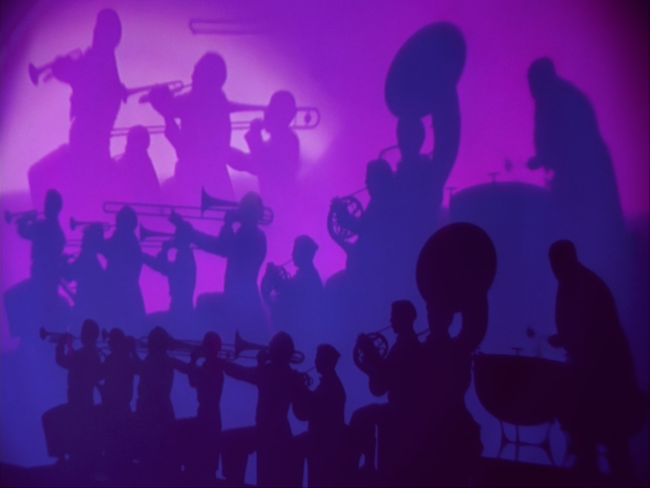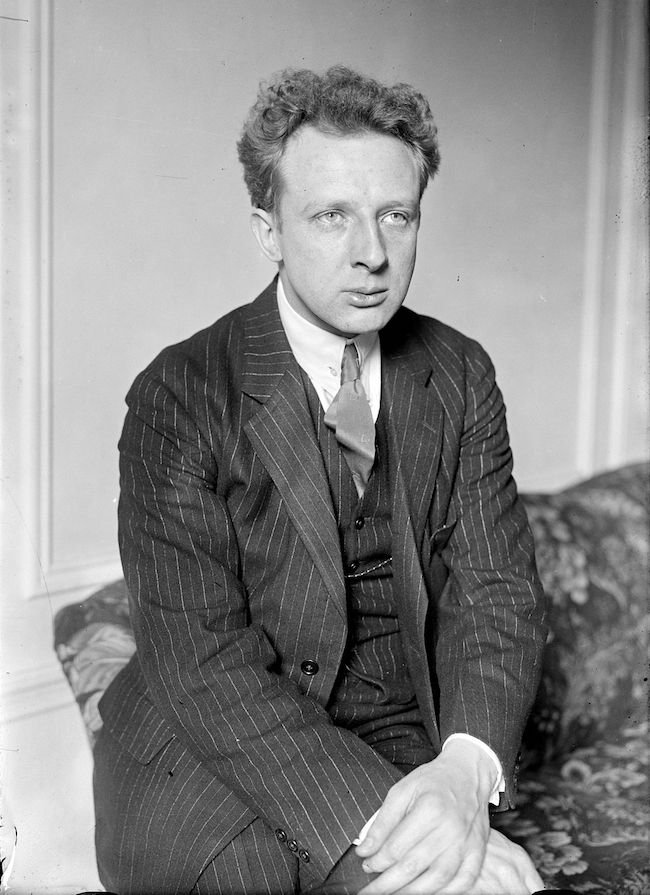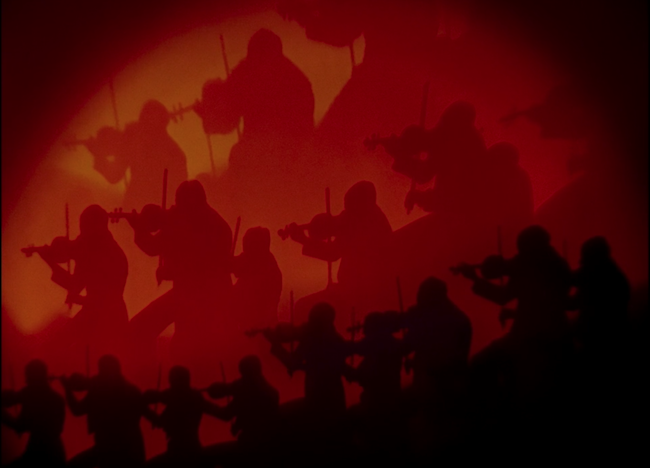The opening musical strikes of Fantasia seem to emanate from a technicolor orchestra. The face of the conductor—silhouetted by a deep purple screen—lights up orange, then yellow, then green by the first passages of the players around him.

Blue bassoons appear on the right, green clarinets above, red violins on the left, and, soon enough, the glowing pink orb of the full orchestra hitting its first crescendo. As the music continues, new silhouetted figures come into view, with harps, trombones, timpanis, and more—each new musician or orchestral section flashing in bright colors, just as you hear the instruments enter the score.
If you were watching the film upon its initial release in 1940, your expectations would have been set by Deems Taylor, the emcee who introduces each of Fantasia's eight segments (and who was sometimes cut from subsequent releases):
"What you will see on the screen is a picture of the various abstract images that might pass through your mind if you sat in a concert hall listening to this music. At first you're more-or-less conscious of the orchestra. So, our picture opens with a series of impressions of the conductor and the players. Then, the music begins to suggest other things to your imagination. They might be, oh, just masses of colors, or they may be cloud forms, or great landscapes, or vague shadows, or geometrical objects floating in space. So now we present the Toccata and Fugue in D Minor by Johann Sebastian Bach, interpreted in pictures by Walt Disney and his associates, and the music by the Philadelphia Orchestra and its conductor Leopold Stokowski.
What Taylor failed to mention is the brand-new way this recorded sound was presented: in stereo.
Up until Fantasia's release, movie soundtracks—and recorded music of all kinds—were presented in mono. Stereo wouldn't become standard on LPs until the 1950s. Direct-to-disc recording was still the norm, with magnetic tape having been only recently invented in Germany, where it was hidden from much of the outside world. And, while there had been experiments and a few public tests of stereophonic sound, only limited audiences had heard them.
Thanks to Disney and Stokowski's experimental spirit, the engineering prowess of Bell Laboratories and RCA, and to Disney's great expense, Fantasia brought stereo sound to the masses. Recorded onto film and played back through a proprietary multi-channel system dubbed Fantasound, Fantasia presented not just a visual but an aural marvel to those lucky enough to catch its 1940 release.
It turned out to be a flash, with the film's stereo presentation being put on pause as World War II raged. But the initial Fantasia roadshow—which took over theaters in 13 cities, including the initial showing at New York City's Broadway Theatre on November 13, 1940—introduced the stereo future to commercial audiences.
Stokowski's Early Stereo Experiments
In the 1920s and '30s, there was something of a revolution afoot in the recording industry, with warring factions breaking down into two groups.

On one side were those who wanted music to be recorded and played back as naturally as possible, as in the earliest, acoustical days of the industry. Musicians played into a sound horn, which funneled their sound down to a needle and disc, and then for playback, this process was simply reversed. On the other side were those who wanted to use the newly available electrical technology—like microphones, amplifiers, filters, and mixers—to record, refine, and creatively playback the sounds they captured.
Stokowski, who helmed the Philadelphia Orchestra from 1912 through 1940, was decidedly in this second camp.
Greg Milner's Perfecting Sound Forever: An Aural History of Recorded Music, recounts Stokowski's embrace of electrical recording. An advocate from its very first days, Stokowski was quick to see the possibilities of the medium, and pushed his orchestra to record in ways that were ridiculed by music critics and other conductors at the time.
The first fully electrical recording of a symphony was Stokowski's, made in 1924. After researchers at Bell Laboratories transformed the Philadelphia Orchestra's Academy of Music hall into a huge recording studio, they and Stokowski made the first-ever stereo recordings in 1931, which they played for a select group of listeners at the Institute of Radio Engineers and the Society of Motion Picture Engineers.
In the following months and years, they invited more and more people to hear their recorded work and amazed audiences further with elaborate live sound tests. Sometimes, audiences would be watching a darkened stage, with large speaker arrays set up in place of the orchestra, whose musicians were actually playing in the basement. In one particularly notable performance, listeners in Washington D.C. heard the live Philadelphia-based orchestra through telephone lines and an onstage speaker array.
But these live sound tests were a way station to the stereo future, while the process of recording in stereo evolved. Because discs were so limited in what they could record directly, Bell engineers came up with a system for recording separate audio signals onto film. This way of recording via optical recorders pre-dated the rise of magnetic film recording, which would become the standard in following decades. Milner describes just how much was involved in the invention:
"The problem with film as a sound-recording medium was that compared with discs, the dynamic range of film (the difference between the softest and loudest sounds it was capable of recording) was limited. Bell's solution was a system that measured the level of the music as it was being recorded. To achieve the stereophonic effect, three microphones were used, all running to their own soundtrack on the film. If the music exceeded a certain volume, the system adjusted it down to the limit while an alternating current alongside the soundtracks expressed how much the sound had been compressed. During playback, each soundtrack passed through a photoelectric cell, which caused an electric current to travel to the amplifier and then the speakers. As it did so, the 'control current' told the system how much to amplify the sound currents so that the sound regained its original volume."
Crucially to Stokowski's work, "the system allowed for the flexible control of each track, so that the music could be 'enhanced' [or, really, mixed] as it was transferred to disc—parts could be made louder or softer, depending on the whim of the enhancer," Milner writes.
As the prime "enhancer" of the world's early stereo recordings, Stokowski exploited the new possibilities of this technology—first, at a notorious Carnegie Hall sound test, where he blasted a Carnegie Hall audience with 100 dB of stereo recordings, and then, with the creation of Fantasia.
The Multi-Channel Making of Fantasia
To record Fantasia, Disney, Stokowski, and RCA engineers teamed up to make an enormous system based off of Bell's invention. Just as Bell engineers had done previously, RCA engineers turned Philadelphia's Academy of Music into one large recording studio.

According to a 1941 Popular Science article about the movie and soundtrack, the performances were captured, in full, by nine cameras, 33 microphones, and "approximately 3,000,000 feet of sound track from individual takes, prints, and remakes." For the final mix, these 3-million feet were "condensed into the final 10,7888-foot, four-track negative."
The nine cameras were split between audio and technical functions: seven captured different instrument groups, one captured the full orchestra, and one was used as a type of click track, with a telegraph providing the tempo that would later sync all of the audio and the movie's illustrations. The eight audio tracks were then mixed down onto three—one left, one center, one right—with many creative decisions made to bring certain instruments higher or lower into the mix. The fourth track of the negative carried the control current, which decided the volume of the other three.
To playback these recordings in movie houses, Disney had to build its own system, an expensive array of devices and speakers they called Fantasound. Developed at Disney studios, multiple setups ended up being made. For the rollout of Fantasia, Disney had to convert existing theaters into multi-speaker setups. Thus, the film found movie-goers not in standard movie houses, but as part of a Fantasia roadshow that touched theaters in New York, LA, Chicago, and other major cities. Each installation cost as much as $85,000 (and that was following music production costs of up to $400,000, in 1939 money).
Fantasound in Action
On November 13, 1940, a New York City audience was able to hear Fantasound in action, at the very first screening of Fantasia. A 2002 history, The Cartoon Music Book, tells the story:
"Even a live performance has never sounded this rich, transparent, detailed. The brilliant sheen of the strings is like a velvet cushion: a foil for the crisp brass, rumbling kettledrums, and delicate harp."
"Later, as Moussorgsky's Night on Bald Mountain tumbles onto the screen, the audience becomes immersed in a pool of pleasurable sound, firing from every direction: sixty-eight loudspeakers strong, pushing the instruments at them, pulling away, following the dramatic movement of the unusual images on the screen. It swoops from the front left and back right, creeping up the aisle like subway steam escaping through a sidewalk grate. When church bells toll ominously from behind, the entire audience turns in their seats, staring at the back wall of the theater in disbelief."
"The audience members are talking now, excitedly—remarking on the purity of sound. 'Could there have been a live orchestra in the pit … ?' These few moments of aural and visual bliss have given them a new respect for cartoons and classical music."
The film's most iconic moments—Mickey Mouse as "The Sorcerer's Apprentice," the dancing brooms and flooding buckets, or even the illustrated "sound track" itself—were matched by music that moved from one side to the other. And, taking the immersive aspect further, in ways that foresaw surround sound, Stokowski's dynamic mixes made it sound as if notes were traveling from front-to-back or back-to-front.
In all, it had a mesmerizing effect on those who heard it, or most listeners at least. While some classical music critics panned it, others were floored by the event. Art Digest's Peyton Boswell wrote at the time that Fantasia was "an aesthetic experience never to be forgotten. Harold Schonberg, recognizing Stokowski's larger contributions to recording, wrote, "More than any other conductor in the history of music, Stokowski was governed by sound, pure sound."
As quoted in a Chicago Tribune article, Stokowski had this to say about what has become his most-famous work: ''In Fantasia we were able to give these important passages their true value by making the melodic lines for bassoon, clarinet and oboe soar above the rest of the orchestra without emasculating the rushing stormy music of all the string instruments. Because of the inherent lack of balance in the orchestration, I have never before heard these phrases given their due prominence and tonal importance.''
Unfortunately, the initial run of the film didn't last long. The continued fighting in Europe and the war rations at home in the United States—combined with the expense of the Fantasound arrays—meant that the Fantasia rollout ground to a halt. Only one Fantasound setup survived, with others being salvaged and "donated to the war effort," according to The Cartoon Music Book.
A diminished roadshow began again in 1941, but this time, the multi-channel recordings were reduced to a standard mono soundtrack.
But while the war diminished Fantasia's immediate impact, the film—in many different edits and re-releases—ended up being one of the highest-grossing films of all time. The stereo soundtrack lay dormant for more than a decade, slowly deteriorating. In a twist of fate, the war that had first dealt the original soundtrack a blow played a role in its restoration.
After American troops defeated the Nazis, they found and took home the impressive magnetic tape recorders the Germans had secretly built. Soon, the benefits were shared in the States and around the world, as magnetic tape became the dominant recording medium, until the industry's later digital turn.
For the 1955 re-release of Fantasia, Stokowksi's original optical recordings were transferred to magnetic tape. Though the original negatives are gone, the fully restored 1940 version is still available today, and the ramifications of the soundtrack's stereo sound are still heard everywhere.
